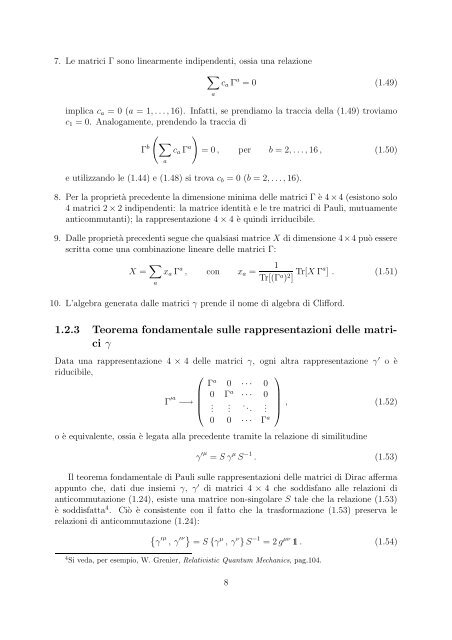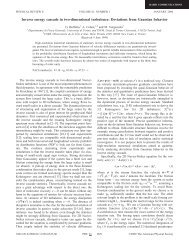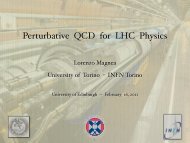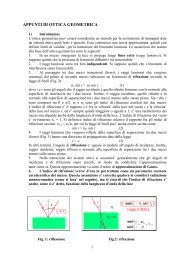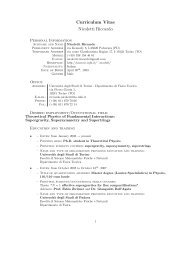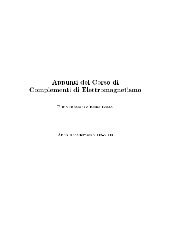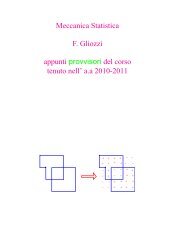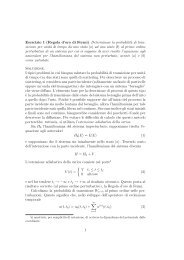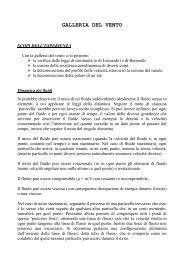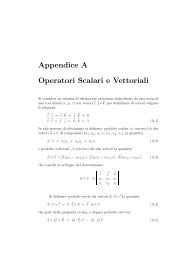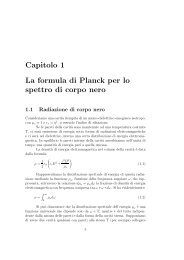Lezioni di Meccanica Quantistica Relativistica A. Bottino e C ... - INFN
Lezioni di Meccanica Quantistica Relativistica A. Bottino e C ... - INFN
Lezioni di Meccanica Quantistica Relativistica A. Bottino e C ... - INFN
You also want an ePaper? Increase the reach of your titles
YUMPU automatically turns print PDFs into web optimized ePapers that Google loves.
7. Le matrici Γ sono linearmente in<strong>di</strong>pendenti, ossia una relazione∑c a Γ a = 0 (1.49)aimplica c a = 0 (a = 1, . . . , 16). Infatti, se pren<strong>di</strong>amo la traccia della (1.49) troviamoc 1 = 0. Analogamente, prendendo la traccia <strong>di</strong>Γ b ( ∑ac a Γ a )= 0 , per b = 2, . . . , 16 , (1.50)e utilizzando le (1.44) e (1.48) si trova c b = 0 (b = 2, . . . , 16).8. Per la proprietà precedente la <strong>di</strong>mensione minima delle matrici Γ è 4 × 4 (esistono solo4 matrici 2 × 2 in<strong>di</strong>pendenti: la matrice identità e le tre matrici <strong>di</strong> Pauli, mutuamenteanticommutanti); la rappresentazione 4 × 4 è quin<strong>di</strong> irriducibile.9. Dalle proprietà precedenti segue che qualsiasi matrice X <strong>di</strong> <strong>di</strong>mensione 4×4 può esserescritta come una combinazione lineare delle matrici Γ:X = ∑ ax a Γ a , con x a =1Tr[(Γ a ) 2 ] Tr[X Γa ] . (1.51)10. L’algebra generata dalle matrici γ prende il nome <strong>di</strong> algebra <strong>di</strong> Clifford.1.2.3 Teorema fondamentale sulle rappresentazioni delle matriciγData una rappresentazione 4 × 4 delle matrici γ, ogni altra rappresentazione γ ′ o èriducibile,⎛⎞Γ a 0 · · · 0Γ ′a 0 Γ a · · · 0−→ ⎜⎝.. . ..⎟ . ⎠ , (1.52)0 0 · · · Γ ao è equivalente, ossia è legata alla precedente tramite la relazione <strong>di</strong> similitu<strong>di</strong>neγ ′µ = S γ µ S −1 . (1.53)Il teorema fondamentale <strong>di</strong> Pauli sulle rappresentazioni delle matrici <strong>di</strong> Dirac affermaappunto che, dati due insiemi γ, γ ′ <strong>di</strong> matrici 4 × 4 che sod<strong>di</strong>sfano alle relazioni <strong>di</strong>anticommutazione (1.24), esiste una matrice non-singolare S tale che la relazione (1.53)è sod<strong>di</strong>sfatta 4 . Ciò è consistente con il fatto che la trasformazione (1.53) preserva lerelazioni <strong>di</strong> anticommutazione (1.24):{γ ′µ , γ ′ ν } = S {γ µ , γ ν } S −1 = 2 g µν 11 . (1.54)4 Si veda, per esempio, W. Grenier, Relativistic Quantum Mechanics, pag.104.8


